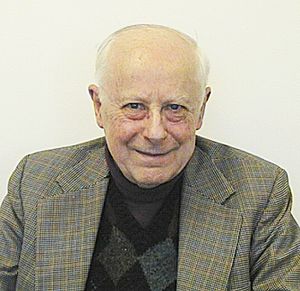William C. Pfefferle facts for kids
Quick facts for kids
William C. Pfefferle
|
|
|---|---|
 |
|
| Born | April 24, 1923 |
| Died | December 28, 2010 (aged 87) |
| Alma mater | Drexel University |
| Known for | catalytic combustion, "Magnaforming" |
| Spouse(s) | Eleanor |
| Awards | ASME Gas Turbine Award ACS Industrial Innovation Award |
| Scientific career | |
| Fields | Chemical engineering |
William C. Pfefferle (born April 24, 1923 – died December 28, 2010) was an American scientist and inventor. He was known for creating new ways to make fuel and energy cleaner. His inventions helped reduce pollution from engines and factories.
Contents
Early Life and Education
William Pfefferle studied chemical engineering at Drexel University. Chemical engineering is about designing processes that change raw materials into useful products. He then earned a higher degree in physical chemistry from the University of Pennsylvania. Physical chemistry looks at how matter and energy behave.
Working on Fuels and Energy
From 1952 to 1956, Pfefferle worked at Standard Oil of Indiana. This company is now part of BP.
In 1956, he joined Engelhard Industries. There, he invented "Magnaforming." This is a special process that helps create a lot of the world's gasoline today. It makes gasoline more powerful and efficient. He also worked on fuel cells that use phosphoric acid. Fuel cells create electricity from chemical reactions.
The "Father of Catalytic Combustion"
Pfefferle was called the "father of catalytic combustion." In the early 1970s, he invented the first catalytic combustor for gas turbine engines. Gas turbines are like powerful engines that burn fuel to create energy.
Normally, burning fuel in these engines creates harmful gases. These include nitrogen oxides and carbon monoxide. These gases can cause air pollution and contribute to global warming. Pfefferle found a way to use a catalyst to make the fuel burn cleaner. A catalyst is a substance that speeds up a chemical reaction without being used up itself. His method greatly reduced the amount of harmful gases released.
Starting His Own Companies
In 1977, Pfefferle started his own company, William C. Pfefferle Associates. He worked on different projects there until 1986.
Later, in 1986, he helped start Precision Combustion in North Haven, Connecticut. At this company, Pfefferle continued to develop clean and efficient technologies. He invented the "Microlith" catalytic reactor. This device helps clean up exhaust from cars and other machines. He also created the RCL catalytic combustor for large power machines.
Awards and Recognitions
William Pfefferle received several important awards for his work. In 2003, he won the American Society of Mechanical Engineers (ASME) Gas Turbine Award. This award recognized his big impact on gas turbine technology.
Also in 2003, he received the American Chemical Society's (ACS) Industrial Innovation Award. This award honors people who create new and important industrial processes.
He was also recognized by the New Jersey Inventors Hall of Fame in 1990.
His Inventions and Patents
Pfefferle held over 100 patents for his inventions. A patent is a legal right that protects an invention. It means only the inventor can make, use, or sell their invention for a certain time. His most important patents included:
- Catalytically Supported Thermal Combustion: This invention helps burn fuels in engines and furnaces. It does this without creating many pollutants and makes the process more efficient.
- Magnaforming: This process makes gasoline more powerful. It also helps make more gasoline from crude oil and makes the equipment last longer.
Pfefferle's many other patents covered different ways to use catalysts and improve combustion.
See also
 In Spanish: William C. Pfefferle para niños
In Spanish: William C. Pfefferle para niños

